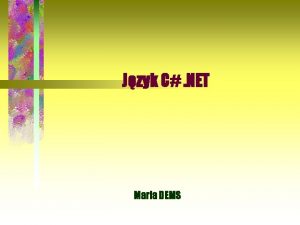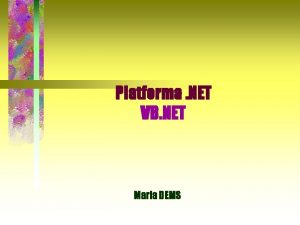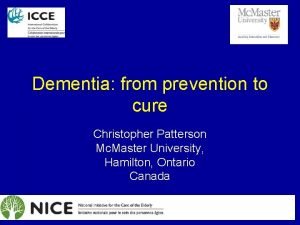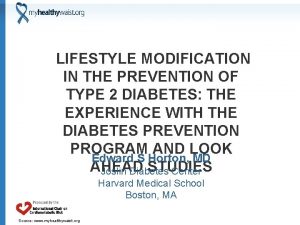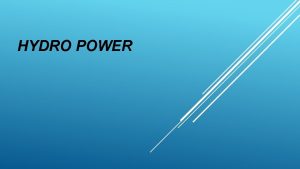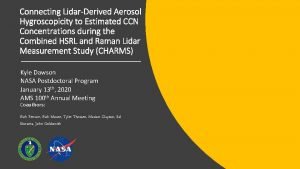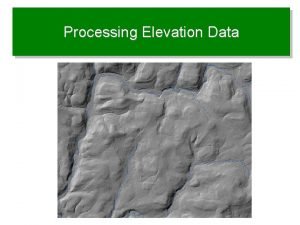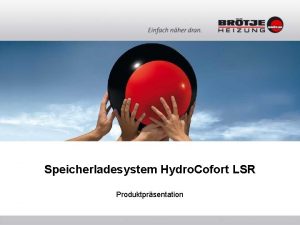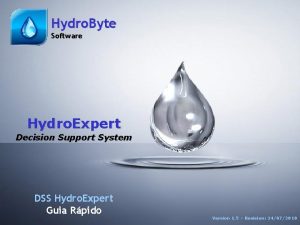HYDRO TREATMENTS OF LIDARDERIVED DEMS U S Department









- Slides: 9

HYDRO TREATMENTS OF LIDAR-DERIVED DEMS U. S. Department of the Interior U. S. Geological Survey

Stereo DTM (Topographic Surface) ☀ ☀ ☀ Stream Waterbody Reference image of the traditional stereo-compiled DTM Built from Masspoints and Breaklines Much coarser resolution than lidar Demonstrates the familiar and usually expected character of a topographic DEM Most notably, the “flat” water surfaces

Pure Li. DAR (Topographic Surface) DEM created only using Bare -Earth lidar points ☀ Surface contains extensive triangulation artifacts (“tinning”). ☀ Cause by the absence of: ☀ Lidar returns from water ☀ Breakline constraints that would define buildings, water, and other features (as in the Stereo DTM). ☀ ☀ Tinning in Water Areas Aesthetically and cartographically unacceptable to most users

Hydro Flattened (Topographic Surface) ☀ ☀ ☀ Stream Waterbody ☀ The goal of the v 13 Spec. Intent is to support the development of a consistent, acceptable character within the NED, suitable for contouring. Removes the most offensive pure lidar artifacts: those in the water. ☀ Constant elevation for waterbodies. ☀ Wide streams and rivers are flattened bank-to-bank and forced to flow downhill (monotonic). Carries ZERO implicit or explicit accuracy with regards to the represented water surface elevations – It is ONLY a Cartographic/Aesthetic enhancement. Building voids are too costly to correct. Most often achieved via the development and inclusion of hard breaklines.

Full Breaklines (Topographic Surface) ☀ ☀ ☀ Buildings Roads ☀ A further possible refinement of the Hydro Flattened surface Removes artifacts from building voids Refines the delineation of roads, single-line drainages, ridges, bridge crossings, etc. Requires the development of a large number of additional detailed breaklines A higher quality topographic surface, but significantly more expensive. Not cost effective for the NED.

Hydro Enforced (Hydrologic Surface) ☀ ☀ ☀ Culverts Cut Through Roads Surface used by engineers in Hydraulic and Hydrologic (H&H) modeling. NOT to be used for traditional mapping (contours, etc. ) Similar to Hydro Flattened with the addition of Single Line Breaklines: Pipelines, Culverts, Underground Streams, etc… Terrain is then cut away at bridges and culverts to model drain connectivity Water Surface Elevations (WSEL) are often set to known values (surveyed or historical).

Hydro Conditioned (Hydrologic Surface) Filled Sinks Another type of surface used by engineers for H&H modeling. ☀ Similar to the Hydro Enforced surface, but with sinks filled ☀ Flow is continuous across the entire surface – no areas of unconnected internal drainage ☀ Often Achieved via Arc. Hydro or Arc. GIS Spatial Analyist ☀

Active Comparison Slide Stereo DTM Pure Lidar Hydro Flattened (click the buttons below) Full Breaklines Hydro Enforced Hydro Conditioned

References ☀ USGS-NGP v 13 Draft Li. DAR Base Specification ☀ Special Thanks to: ☀ Hans Karl Heidemann ☀ Jeremiah Ross Vinyard-Houx ☀ James V Mauck
